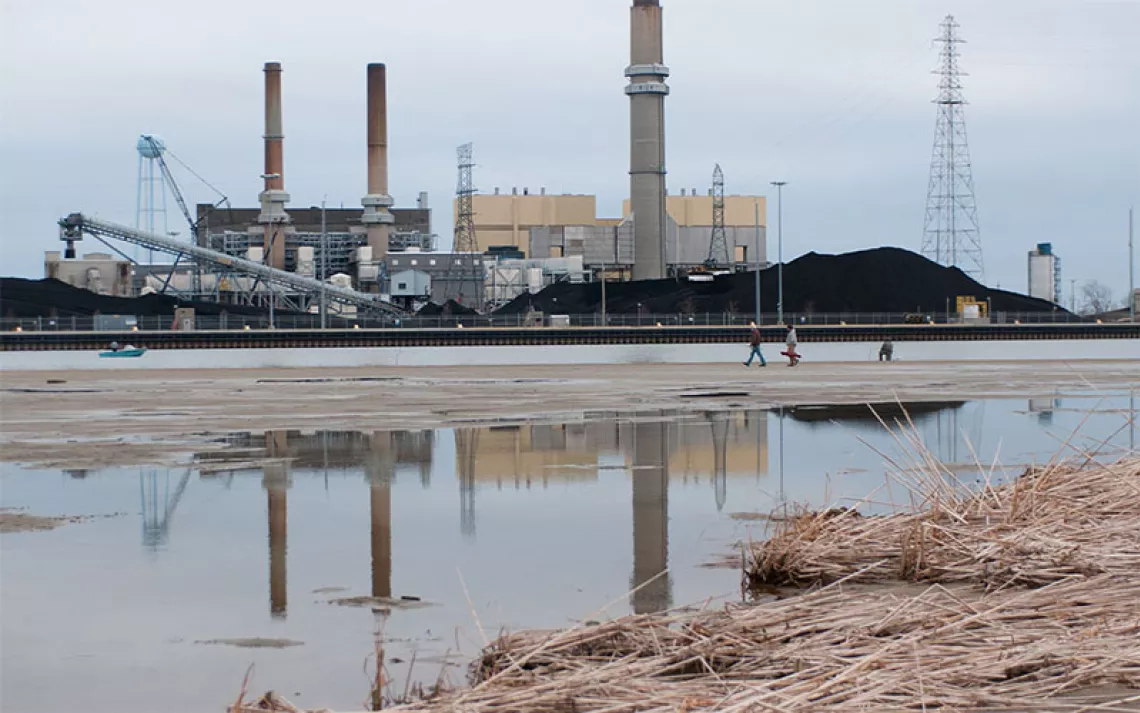TPC Chemical Plant Explosion Dumps Toxics Into Community
Residents make clear they’ve had enough

Ray Moore trains his dog Aries with a cloud of smoke in the background from the TPC Group Port Neches explosion on November 27, 2019. | Photo by Marie D. De Jesus/Houston Chronicle/AP Photo
Just before 1 A.M. on the morning of November 27, a massive explosion rocked the small town of Port Neches in southeast Texas. The shock wave, which could be felt for miles around, blew out front doors, shattered rafters, and brought ceilings tumbling down in hundreds of homes surrounding the TPC Group’s 218-acre chemical plant.
“It felt like the end of the world,” said Terri Gunter, who lives in a middle-class residential neighborhood just across the street from the plant. Gunter and her two grown children were asleep in their house at the time of the blast. They awoke, ears ringing, to discover that all of their storm windows had been blown in. When they looked outside, they saw a massive pillar of fire rising up into the sky from the plant. Three workers were injured in the blast and a man in the nearby town of Groves suffered a heart attack, allegedly because of the shock; his widow is now suing the TPC Group.
Built in the 1940s, the TPC Group plant produces over 900 million pounds of butadiene and raffinate every year. (Butadiene is a key component in the synthetic rubber used to make car tires.) EPA records reveal the plant’s extensive regulatory violations, which resulted in four formal and five informal enforcement actions in the past five years and over $100,000 in fines. In 2017, the TPC Group entered a consent agreement with the EPA that required the plant to conduct fence-line air monitoring for 1,3 butadiene, a known carcinogen. If the level exceeded 25 parts per billion twice in a one-hour period, the company had to notify the public. In September, one of those tests measured butadiene levels of 14,846 parts per billion.
Although the Chemical and Safety Hazard Investigation Board is still investigating the cause of the explosion, Neil Carman, the clean air director of the Sierra Club's Lone Star Chapter, believes it likely started with a butadiene leak. “1,3 butadiene is extremely dangerous to work with, and the fence-line monitoring reports show they were having a lot of leaks over the three months leading up to the explosion,” he said. The leaks could have come from a faulty valve, flange, connector, or other pipeline component. “The air along the Gulf of Mexico is very salty, and when that air comes into contact with metal it causes accelerated corrosion,” Carman said. “Some of these plants are just explosions waiting to happen.”
Following the blast, local officials issued a mandatory evacuation order for Port Neches and surrounding communities. The next day, they allowed residents to return to their homes, only to issue a series of shelter-in-place orders after repeatedly finding high concentrations of butadiene and benzene in the air. A week after the explosion, the air pollution was bad enough to force the Port Neches school district to cancel classes for several days. Port Neches High School sits directly across a chain-link fence from the plant, as do the city’s little league baseball fields. Officials also warned residents to be on the lookout for asbestos from the plant that might have been deposited in their yards by the explosion.
Some Port Neches residents have decided enough is enough. On a recent Saturday afternoon, a family could be seen boarding up their shattered windows and garage door with plywood, then driving off in a U-Haul. Down the street, Gunter said she wants to leave town as well. She worries that her house has structural damage; its brick walls were noticeably bowed out. “I don’t feel safe here,” she said. “We’re just waiting for an apartment in Nederland [a nearby town] to come available, and then we’re leaving.”
Environmental-justice activist Hilton Kelley felt the shock wave from the blast in his house in Port Arthur, nearly three miles from the TPC Group plant. It wasn’t the first time he’s experienced such an event—this area of the Texas Gulf Coast is home to one of the world’s largest petrochemical refinery complexes. As a result, communities have become accustomed to a seemingly endless series of industrial accidents, fires, and explosions. Jefferson County, which includes Port Neches and Port Arthur, has elevated rates of cancer, heart and respiratory conditions, and skin disorders.
“I could see the fire from my balcony,” said Kelley, the founder and executive director of the Port Arthur–based Community In-Power and Development Association. “I would guess the smoke plume stretched for 45 miles, and there were these fine particles raining down on the communities under the plume. The wind direction kept shifting, so there was a pretty broad area that got sprayed.” The Texas Commission on Environmental Quality (TCEQ) is the state environmental agency, but critics have long charged that it’s too cozy with the petrochemical industry. “They’re slow to enforce the laws, slow to press fines, slow to press the companies to do the right thing,” Kelley said. “They’re quick to look the other way and work with these guys.”
Carman, who worked at the TCEQ for 12 years before coming to the Sierra Club, agrees that the agency needs to be much more aggressive about cracking down on pollutors like the TPC Group. “These plants are extremely dangerous,” he said. “They’re loaded with leak points, and you have people living right on the fence line. The regulation really is not sufficient."
Although some Port Neches residents have said they want the plant to reopen—the petrochemical refineries are the region’s economic engine, after all—others have soured on the TPC Group. Gunter’s father took a job at the plant (then owned by Neches Butane) after returning home from World War II and worked there through the 1980s. “A lot of people here want to put their heads in the sand and say, well, nobody died,” she said. “But we’re angry. It’s the company’s responsibility to make this right.” After the blast, a TPC Group employee from St. Louis came by the house to give them a company phone number to call for assistance, but every time Gunter calls, the line is busy. Her 24-year-old daughter, Kendall, who was in the house at the time of the explosion, said the family has lost faith in the company.
“They just don’t give a shit,” she said.
 The Magazine of The Sierra Club
The Magazine of The Sierra Club



